
The Ultimate Guide to Pentatonics for Jazz Guitar
Aug 06, 2020A Counter-Intuitive Approach to Modern Jazz Improvisation in Six Parts
In this jazz guitar pentatonics article and accompanying videos we will study pentatonic scales and how to use them in jazz guitar improvisations.
Jazz history reveals extensive use of pentatonics and throughout this article we will gradually move forward starting with the construction of two very common and simple to use pentatonic scales. We will then work on them over the entire fretboard using positions and several patterns. Finally, we’ll see how to apply pentatonic scales on chords and chord progressions in major, minor, dominant, half-diminished, altered and more.
Enjoy!
Table of Contents
Jazz Guitar Pentatonics
Part 1 What are Pentatonics and How to Construct Them
Part 2 Explore Pentatonics over Entire Fretboard
Part 3 Patterns for Pentatonic Scales
Part 4 Play-Alongs, Backing Tracks, PDF's
Part 5 More of the Fun Stuff and Darker too
Part 6 ii-V-I Improvisation using Pentatonic Scales
Jazz Guitar Pentatonics - Part 1
What is the Pentatonic Scale?
Penta means Five.
So, pentatonic scales contain five notes. Therefore, we could say that any five notes constitute a pentatonic scale, but for now, we will look at the most common ones in use.
Here’s how to extract the “regular” pentatonic scales.
Let's start with the C major scale.
C – D – E – F – G – A – B – (C)
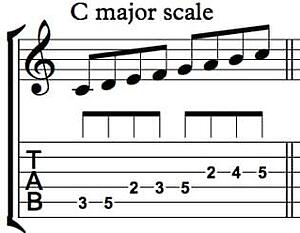
If you know your major scale theory a little, you may remember that half steps exist only between E-F and B-C. Looking at those troublesome notes (F and B), we get the interval of a tritone, the most naturally tense interval in the scale that REALLY needs to resolve.
To get the pentatonic scale, we simply remove this “tension” from the major scale to keep only the most stables notes. The troublemakers are F and B, corresponding to the scale degrees 4 and 7 so,
by omitting them, we get:
C – D – E – G – A – (C).
This is the C major pentatonic scale, also spelled in intervals as:
1 – 2 – 3 – 5 – 6 – (1).
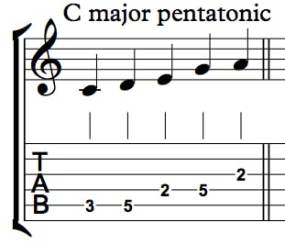
Therefore, we can conclude that the removal of the 4th and 7th degrees from a major scale creates a pentatonic scale using this formula.
This seems simple enough,
so let’s take a look at some major and minor pentatonics.
Jazz Guitar Pentatonics: Major and Minor
Some musicians like to use the minor pentatonics as a point of reference, possibly due to its’ popularity in some instructional materials. So, if you get books on pentatonic, they’ll use the minor pentatonic as the starting point.
As a result, and after I thought in major pentatonic scales for a while, I found it better to relate to pentatonic scales by their minor counterpart, because it is just more universal.
Here’s how to get to the relative minor pentatonic. Start on the fifth note of the major pentatonic, which used to be the 6th degree of the major scale.
In C major pentatonic:
C – D – E – G – A – (C).
—-> Start on “A” note to get the
A minor pentatonic:
A – C – D – E – G – (A)
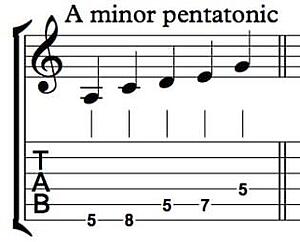
Notice that the minor pentatonic scale has the following spelling:
1 – b3 – 4 – 5 – b7 – (1).
This is the same concept as relativel minor and major scales. You may recognize the good old “blues box”, whereby if you add only one note to this you get the SRV / Hendrix / Jimmy Page / AC DC / BB King traditional BLUES SCALE.
Subsequently, the formula could be created by removing the 2nd and 6 degrees from a natural minor scale to get its’ pentatonic.
Although this may seem like all there is to know, there’s more!
So, let's modify this minor pentatonic to get another more obscure one.
Other Jazz Guitar Pentatonics
Ok, you’ve got the theory down for the most common pentatonic scales (major and minor) above, but you may start to wonder about all the other possible five-note scales. Well, let’s see.
While I believe it’s always good to practice as many options as possible, pentatonics application is where it gets very interesting. So, less is more because you only need to know one or two jazz guitar pentatonics, and it will sound very good in applications.
For instance, we’ll consider later in this article that the simple use of a minor pentatonic applied to 5 or 6 different chords, can always outline different extensions of the same chord.
Basically, I am saying that one pentatonic goes a long way. Furthermore, we’ll be using only TWO pentatonics throughout this article.
Since major and minor pentatonic scales are basically the same, we need one more spelling (the one we did not look at yet).
The D7 Pentatonic
Here’s the only other pentatonic possibility that I use often from within the regular minor pentatonic; lower the b7 a half step to the 6th to get this:
A normal minor Pentatonic is,
A – C – D – E – G – (A).
Lowering the b7 to the 6th, we get:
A – C – D – E – F# – (A).
If you know your II-V’s well, you may have realized that this outlines the Am7 to D7 progression, all by lowering the b7 of Am7 to become the 3rd of D7.
Most people, including myself, like to call this new pentatonic the D dominant 7th pentatonic, or the
D7 Pentatonic shown here:
D – E – F# – A – C – (D) and spelled: 1 – 2 – 3 – 5 – b7.

Some people call this same scale the Am6 pentatonic.
The Am6 Pentatonic with A – C – D – E – F# – (A) and Spelled, 1 – b3 – 4 – 5 – 6 – (1) can be kept in mind if it works for you.
Jazz Guitar Pentatonics Part One Wrap Up
In summary, you only need to know two pentatonic scales and you can go a very long way.
- The Minor Pentatonic (1 – b3 – 4 – 5 – b7)
• The related Dominant 7th Pentatonic (aka Minor 6th)
Change only one note from the minor pentatonic and you get the related Dominant 7th. So, try and spell them in all keys to really up your game.
For example, the Cm7 Pentatonic Scale is C, Eb, F, G ,Bb, and C. If you start playing on a different note such as the F when playing over the F7 chord, you get the following as a result:
F7 Pentatonic (F G A C Eb F) (aka Cm6 penta). Consequently, the Bb has been removed and it is an A that makes it sound correct.
Try and spell the notes in your head for the following:
Dm7 – G7
Gm7 – C7
Cm7 – F7
Fm7 – Bb7
Bbm7 – Eb7
Ebm7 – Ab7
Abm7 – Db7
C#m7 – F#7
F#m7 – B7
Bm7 – E7
Em7 – A7
Am7 – D7
Now play them on the guitar
If you didn’t memorize II-V’s in all keys yet, now would be a good time!
In Jazz Guitar Pentatonics Part 2, we will study those pentatonic scales over the entire fretboard, in positions.
Grab your guitar and let’s get at it.
Jazz Guitar Pentatonics - Part 2
Five Positions for Pentatonic Scales
You are going to enjoy Part 2, so let’s get to it and look at our two favourites, the Am and D7 jazz guitar pentatonics scales from Part 1, and this time, we’ll review them in five different positions on the fretboard.
Don’t be intimidated by the amount of materials here because the beauty of the pentatonic scales for guitarists is that we only have two notes per string! You can’t beat that.
Watch the above video and relax.
On the Fretboard in Five Positions
There are five really practical positions for playing pentatonics on the guitar fretboard. This scale organizes itself in “2 notes per string” patterns everywhere on the fingerboard and as a result, many guitarists use pentatonics, but really, they sound great too if you know where and when to use them. Let’s get to those five positions.
I personally discovered the five positions for myself through the 7 major scale positions or “boxes” I was already familiar with. I subsequently figured out that 2 of those positions were not practical enough, plus I had to adjust fingerings for the others.
Here is a good read to help with this: article series on position playing …. Go ahead to that article but continue to read on about the 7 major scale positions here, but just leave the other article open in another window and come right back to this one.
String/Finger Positions
If you read and understood part II and III of the positions article, you have the “string–finger” system down.
Here’s where the pentatonics fall on the guitar neck:
- 6-4
- 6-2
- 6-1 (in fact = 4-2)
- 5-4
- 5-2
From those “string – finger” positions, you can apply pentatonic scales on the whole fretboard simply by removing two notes from the appropriate major scale. Remember, the major pentatonic is 1 2 3 5 6 and the minor pentatonic is 1 b3 4 5 b7. So, if you know your entire seven positions of the C major scale (as discussed in the article series shown above), you consequently have everything you need to play the A minor pentatonic on the entire fretboard.
And, we don't have to use the complete seven positions here. We will omit two of them because five positions suffice.
You can relate it to the CAGED system if you are familiar with it (unlike myself).
Just in case this is all still Greek to you, here’s a complete PDF with the 5 jazz guitar pentatonics positions written out in Am (standard notation + TABS). It contains the notes A C D E G and if you can at least play through that, you already have 80% of the work done.
Part 2 Pentatonics Wrap-up
Furthermore, you may wish to learn the related dominant 7th pentatonic of D7 (aka Am6 pentatonic), and you can simply do this by lowering all the “G” notes to “F#”. Consequently, the D7 pentatonic scale contains the notes A C D E F#.
It is highly recommended you learn the D7 pentatonic at the same time as the Am pentatonic because you will find yourself using a lot of the dominant 7th pentatonic when applying them in parts 4 and 5 of this article.
Practice it lots and lots, so it becomes part of you, in all five positions.
Although playing the five positions up and down (as in the PDF above) is a good way to memorize the concept, it would be even better to spice things up a little bit. And, it is exactly what we will be doing in the next part. We’ll go even further by practicing some interesting patterns.
Jazz Guitar Pentatonics - Part 3
Patterns for Jazz Guitar
Finally, some fun stuff! Let’s get those jazz guitar pentatonics moving. If you did your homework from parts 1 and 2, you should know what pentatonic scales are and how to play them all over the fingerboard.
Once again, we will focus our attention on the minor and “dominant 7th” pentatonic scales. Here are my favorite pentatonic patterns to practice at first, and the reasons why I believe you should have fun practicing them too.
Watch the video above:-)
Patterns: Get Scales in Pentatonics Moving!
When first starting out learning pentatonic scales, it is important to apply patterns. I, therefore, recommend you simply use the patterns contained in this article as soon as you are comfortable with one fingering/position. The patterns are useful to get “the fingers moving” rather than blandly running the scale up and down. Once you have memorized the scale in the easy “up and down” motion, go for some patterns right away.
Some words of advice: using pentatonics is all about creating beautiful, intricate, complex, and sometimes what might seem strange angular melodies. We are breaking out of the usual diatonic (7-note) scales and we seek as much freedom and neat ideas as possible. Therefore, don’t box yourself in again or fall into the trap of making them “flashy” by running patterns as fast as you can, because it won’t be musically meaningful to you or to others.
Practice the patterns slowly, evenly, in good time, with a good posture and hand position. And please, always aim for a full sound on each note. If we cannot hear every note very well, you are probably practicing the patterns too fast.
Four Fun Patterns for Jazz Guitar Pentatonics
We are only using four? Isn’t there, a ton of patterns out there?
Sure, but this is a starting point, something to sink your teeth into.
Later on and once you are versed in the basics you can practice many more patterns as desired.
Pentatonic scales really lend themselves to patterns! Here’s a Jerry Bergonzi book that contains many interesting patterns: Inside Improvisation Series Volume 2 – Pentatonics. It comes with a neat play-along CD too!
So, without further ado, here are my four favorites “basic” patterns:
1. (Ascending)
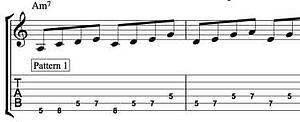
2. (Ascending)

3. (Descending)
4. (Descending)
Here is the PDF file containing the FOUR basic patterns for jazz guitar pentatonics in Am, 5th position.
The four patterns written in Am pentatonic are all four-note patterns: two ascending and two descending. These patterns are in the “classic” fifth position for A minor pentatonic, but I strongly recommend that you learn the four patterns in all five positions. Go slow!
Furthermore, learn the four patterns for both the A minor and the D7 pentatonic scales learned in parts 1 and 2, in the five positions.
These steps are doable for you, right now and here’s why.
You should be able to play the Am7 minor pentatonic and the D7 (dominant) pentatonic in all five positions if you have followed this article and watched the videos so far.
That is ten scales so far and if you are able to apply the four basic patterns above, it means that you now have 40 different “exercises” for your pentatonic scales in total. That’s quite a tool kit and it represents a good bit of work. Therefore, keep it up and it will be quite manageable at this point.
Jazz Guitar Pentatonics: Foundations
The work that we have accomplished to this point is a great foundation and sets you up for even more advanced patterns and concepts if you wish to incorporate the sounds of Jerry Bergonzi, Barney Kessel, Kenny Burrel, Pat Metheny, (etc.).
Remember to relax and breathe, as slow and steady wins the race. Go slowly and learn the pentatonics and the four patterns and as a result, will put you well on your way to great sounding stuff!
The magic really lies in the application of jazz guitar pentatonics to chords and progressions which we will discuss in the rest of this article where there are some really neat improvisation ideas.
Caution: don’t become technically proficient for the sake of being flashy and fast. It is always “music first”! This won’t be a problem at all if you stick to learning and practicing patterns that inspire you and use these scales and concepts to create meaningful and soulful improvised melodies.
Jazz Guitar Pentatonics - Part 4
Applications for convincing solos
Let’s turn up the heat a little on this one because we are going to take everything we've studied so far in this article and apply it to improvisation on actual chords, to play convincing jazz guitar improvisations. We are now learning to improvise and apply the jazz guitar pentatonic that we have learned versus other typical jazz guitar scales.
This is where the fun begins since we’ll finally start to apply minor and dominant pentatonic scales on harmony and work on them using static chords which will closely resemble what you can stumble upon in real playing situations.
Since there are so many chord types to deal with, (that’s Jazz, right?!) we’ll have to break this down into two parts.
Part 4 will deal exclusively with major and minor chords. We’ll consider different types of major and minor chords too. We have 9 applications to look at in this part and in Part 5 we’ll look at darker types of chords.
Watch the video above.
Applied Pentatonics for Jazz Chords
Ok, before we start, here’s my little “treatise” on using pentatonics for jazz guitar improvisation over a certain type of jazz chord.
- These approaches are only my suggestions.
They come from my very own practice and experience and are what “works for me“. Feel free to experiment and make sure you listen for your favorite sounds. Never mind what the teacher said, do your own thing! Also: read books on the matter to give you other, fresh ideas. Here are two great suggestions: Jerry Bergonzi’s Volume 2 and Steve Khan’s Pentatonic Khancepts. - The scope of my approach is only on a “chord to chord” basis.
The examples do not necessarily work on all jazz guitar solos or chord progressions. I simply aligned a SINGLE chord with a SINGLE pentatonic scale choice. Applying pentatonic scales to chord sequences could be the topic of another article. However, if you’d like to apply pentatonic scales to improvisation on chord progressions, consider the examples below as a buffet of scales in which you can pick and choose your favorite “flavours”! -
Go by sound!
Listen and then listen even more! You’ll gain very little by wailing and noodling on a certain pentatonic application if you can’t sing, hear and play some simple improvised melodies on it. To play convincing jazz guitar, you have to “hear” the lines first. Try and see if you can come up with beautiful yet convincing basic pentatonic ideas on some of your favorite tunes. Also, you don’t necessarily have to play just pentatonics for your whole solo. You could for instance, dedicate pentatonic applications to just a few of the chord changes within the song.
More for Your Consideration
-
Apply Carefully.
Work on the different pentatonic sounds you like over chords during your practicing but NOT in your performance. Never try to bruteforce an idea you practiced into your performance just for the sake of doing it. There lies the danger of learning new things. We can get impatient and seek to use “it” right now! We all wish we had the flexibility of Woody Shaw or Wayne Shorter with pentatonics, but, once more, be careful and patient. What you practice will show up eventually, when you are ready and the musical context is optimal.
-
Know your pentatonics first!
Know the Am and D7 pentatonics as we worked on in Part 1. Then practice the five jazz guitar positions for these pentatonic scales, as seen in the PDF in Part 2. Then, practice the four nice pentatonic patterns from Part 3. Remember, all you really need is a minor pentatonic scale and its dominant counterpart. Think Am7 to D7 to keep this in your memory.
Jazz Guitar Soloing with Pentatonics
I have four favorite soloing applications here: two for the normal, unaltered major chord and two for the Lydian-sounding chord
(i.e., chords which have a #11).
Soloing on Unaltered Major Chords
Apply this on a plain C major chord.
Use the minor pentatonic from degree vi or degree iii.
- Degree vi is simply the relative minor. On C major, use A minor pentatonic. This is the most obvious pentatonic application of all since we know A minor pentatonic contains the same notes as C major pentatonic.

- In the diagram below, you will see that degree iii is a standard substitute for I, or the root. On C major, use E minor pentatonic. I say that it is a “standard” substitute because:
C major 7th = C E G B
E minor 7th = E G B D (notice the three notes in common).
This is the more interesting application for “straight” major chords because the degree iii application uses some extensions (7th and 9th).

The one above (using Em pentatonic on C major) is my favorite pentatonic application for unaltered major chords.
— Click to hear the backtrack for Cmaj7.
Solo On Lydian Chords
- Use a minor pentatonic from degree vii or a dominant pentatonic from degree ii. Degree vii is “note sensible”.

2. Starting on degree ii is the “Take the A Train” chord. On C major (#11) use D7 pentatonic.
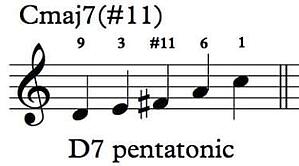
— Click to hear the backtrack for Cmaj7(#11).
Convincing Jazz Guitar Pentatonics on Minor Chords
Here are five great soloing applications below.
The basic minor 7 chord is often associated with the Dorian Mode and here are my first two favourites in the minor chords:
- Soloing on Degree i
- On Degree v
The tonic minor chords with a 6th or Minor-Major 7th degree are three great starting places:
- Start on degree i
- Degree iv
- On degree v
Minor 7th Chords
Use the minor pentatonics on degree i or degree v.
- Degree i starts on A (root):
On Am7, use Am pentatonic as below:
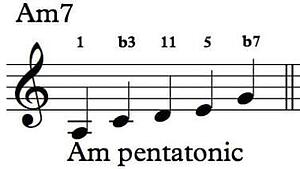
2. Degree v has more extensions.
So, on Am7 simply use the Em pentatonic.

I like the second because it gives just enough “spice” to my improvisations!
— Click to hear the backtrack for Am7.
Tonic Minor Chords
On Tonic Minor Chords (m6 and/or minor-maj7th chords), use the minor pentatonic on degree ii and dominant pentatonics degree iv and degree v.
As follows:
- Degree ii gives a minor 6/9 sound: On Am6, use Bm pentatonic.
- The degree iv dominant is really the minor 6th pentatonic.
On Am7, use the D7 pentatonic, (aka Am6 pentatonic). This is just like playing on a ii-V from the root, which makes it easier to remember!
- Using the degree v dominant is also like literally playing on the ii-V. On Am6, use E7 pentatonic (aka Bm6 pentatonic). It consequently gives the minor-major 7th sound

Practice applying the suggestions above using the play-along vamps provided. See which ones make sense and sound good to you. Keep in mind that it is possible that some of my suggestions are too “foreign” and strange for you. Just do your own thing with these.
In the next and final part of this article, we are going to look at some darker-sounding stuff using dominants, half-diminished, altered dominants...
— Click to hear the backtrack for Am6.
Jazz Guitar Pentatonics -Part 5
Dominants, Altered Dominants, and Half-Diminished Chords
This last part is basically a follow-up to Part 4, where we applied interesting pentatonic options on major and minor chords. However, we saved these “darker” dominant chords, half-diminished (minor 7 flat 5) chords, and altered dominant chords for the big finale, so if you read Part 4 a while ago, do yourself a favour and review the beginning of Part 4.
Watch the above video.👆
Jazz Guitar Pentatonics on Dominant Chords
This will be especially relevant when we discuss two great suspended dominant sounds (sus4 or 11) and two unaltered dominant sounds, one with no altered extensions and one with a dominant #11 sound, also known as Lydian dominant.
Suspended Dominant Sounds (sus4 or 11)
- Use the minor pentatonic from degree v, and also from degree ii.
- The degree v application is simply the related “ii chord” of an existing ii-V cadence. So, if you want a suspended sound on the V, stay on the minor pentatonic of the ii. For example, in Am7-D7, if we want a D7 (sus), just use A minor pentatonic.

- The application using the minor pentatonic from degree ii is simply a suspended sound with the added bonus of a 13th (aka 6th degree), so this gives a bit more of a modern sound. Use Em pentatonic on D13 (sus). It is still just one note away from Am pentatonic.

— Click to hear the backtrack for D7(sus4).
Unaltered (“Plain”) Dominant Chords
Play over a Plain D dominant chord.
Apply the dominant pentatonic from degree i or minor pentatonic from degree vi.
- This application uses degree i. On D7 chord, use D7 pentatonic.
- The application using the minor pentatonic from degree vi clearly outlines a dominant 13th type of sound, so this should not come as a surprise, because on the D7 chord we use Bm pentatonic, which is simply D major pentatonic!
— Click to hear the backtrack for D7.
On Dominant Chords with a #11
3. Use the dominant pentatonic from degree ii.
There is clearly a one-note difference from the above. “Use Bm pentatonic on D7”. Now we use E7 pentatonic instead. The one note difference (A to G#) is the #11 of the D7 chord. And we are missing this image at the moment.
The notes of the E7 pentatonic are: E – F# – G# – B – D. When analyzed to a D7 chord, the notes are: 9 – 3 – #11 – 13 – 1.
— Click to hear the backtrack for D7(#11).
Pentatonics on Minor 7th (b5) Chords
This is perhaps, the hardest to hear of the jazz guitar pentatonic applications. (It is the hardest for me anyways.) This is because the minor seventh flat five chord (aka half-diminished) makes itself hard to love in some situations.
However, choices will become more obvious when dealing with complete progressions when you extend your knowledge and playing in this way. But for now, the suggested application works well on a static F#m7(b5) vamp.
Am, Em, Bm and D7 pentatonics all fit on F#m7(b5).
Therefore, use the minor pentatonics from degrees biii, iv, bvii, or use the dominant pentatonic from degree bvi.
At this point, you probably have a fair handle on applying different pentatonic scales to the same chord or sound. I will simply list the applications with degrees outlined.


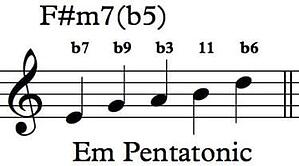
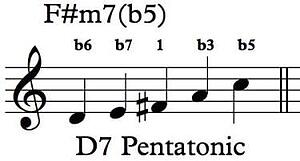
Here’s my “beef” with the pentatonic application for the F#m7(b5) above. None of them include the natural 9th degree. Furthermore, only two of them include the flat fifth!!! However, we clearly hear the natural 9th on minor7(b5) chords played by Jazz pianists from the 1960’s and on. (Think Herbie Hancock.)
In summary, this means that the above list of suggestions is incomplete, so you may want to do some of your own research.
— Click to hear the backtrack for F#m7(b5).
Pentatonics on Altered Dominants
This is the easiest and hardest one at the same time! In fact, ANY pentatonic can work on an altered dominant, as long as it “lands” on a proper resolution. As a result, take these suggestions as a great starting point.
The neat thing about pentatonics is that we can pick and choose a scale that clearly outlines the altered notes we really want to hear, for instance, b9, #9, b5 (aka #11), #5 (aka b13). Here are my suggestions:
Therefore, use the minor pentatonic from degree biii or dominant pentatonic from degree bvi or the dominant pentatonic from a tritone up.
Most noteworthy is, this first choice is “perfect” in terms of outlining the altered tones and we have the b7 along with all the alterations (such as sharp and flat ninths and fifths!).

The second choice is “equivalent” to the first one, but now, the 3rd is present along with all altered tones.

And lastly, differing only by one note from the Am pentatonic application above, we have this simple trade-off: the root (tonic) of the F#7 instead of the b9.

It’s worthwhile exploring other altered dominant pentatonic possibilities. This chord type lends itself to very high degrees of chromaticism. All twelve notes are an “acceptable” choice for altered dominants!
Even if you wind up not using some of the applications you work on very often, you will, however, musically stretch your skills and get a little finger workout in the process.
— Click to hear the backtrack for F#7(alt).
About Resolving Altered Dominants
And, one last thought: rarely will you find yourself in a playing situation where you just sit on an altered dominant chord for an extended period of time. More often than not, you will resolve back to something. For instance, after F#7(alt), you could go to some sort of B chord (B minor of B major).
It would be wise to practice with backing tracks that have that type of resolution. Say, 4 bars of F#7(alt), then 4 bars of Bm, whereby you can apply the stuff you've learned in Part 4 on the B minor chord!
Check out iReal Pro (for Mac), where you can create these types of accompaniment very easily, and it’s cheap too.
Jazz Guitar Pentatonics – Part 6
ii-V-I Improvisation using Pentatonic Scales
In this part, we’ll discover three different “solutions” to improvising on the ii-V-I cadence (in C major) using nothing but pentatonic scales. Note that the materials in this lesson can be applied to any instrument.
First Solution: Ascending Pentatonics a Half-Step Apart
As described in the video, simply use Am, Bbm, and Bm pentatonics on the progression Dm7 – G7 – Cmaj7. Here’s the analysis of chord degrees:

Special attention must be given to the last pentatonic scale, whereby applying the Bm pentatonic on a C major chord allows us to hear the #11 note, and as a result, makes the line sound like the Lydian mode. Please do resolve that note (in our case an F#) to the 5th of the chord (in our case, the G note) if you hear it.
Second Solution: Pentatonics “up and down” a Half-step
Here is another simple, elegant, and “modern” solution: On Dm7 – G7 – Cmaj7 chord use Em, Eb7, and Em pentatonics.
Third Solution: The Tritone Sub!
This is my favorite, and it is quite similar to our first solution above because we simply change the pentatonic scale choice for the V chord. On G7, we use the dominant 7th pentatonic a tritone away. On G7, simply use the Db7 pentatonic.
The tritone substitution is an infamous one! We can hear these types of sounds throughout recorded Jazz history, especially since the Bebop era. Consequently, the beauty of this simple and effective sub is that both chords share their tritones (i.e. 3rd and 7th), and the guide tones are the same.
When examined closely, we can say that the altered chord (or scale) is simply a tritone substitution.
Also, see this jazz guitar lesson page for interesting chord subs…
Once again, be careful with the Bm pentatonic on a Cmaj7 chord because we have the F# note (#11), which might steer you to resolve to G if needed.
— Click to hear the backtrack for Long II-V-I in Cmajor.
BONUS: Jazz Improv with Pentatonics
In this more recent video, we discuss more ways how you can improvise on a II-V-I using the pentatonic scale. Check it out!
That’s it!
I hope this article on jazz guitar pentatonics can help you develop your own ideas and concepts for improvisation. Remember, whenever you’re in doubt, go back to the basics. Less is more. Go back to learning the minor pentatonic and dominant pentatonic shapes over the fretboard as we discussed in Part 2 and continue working on simple fun patterns as we did in Part 3.
Practice well and develop your own sound and concepts!












